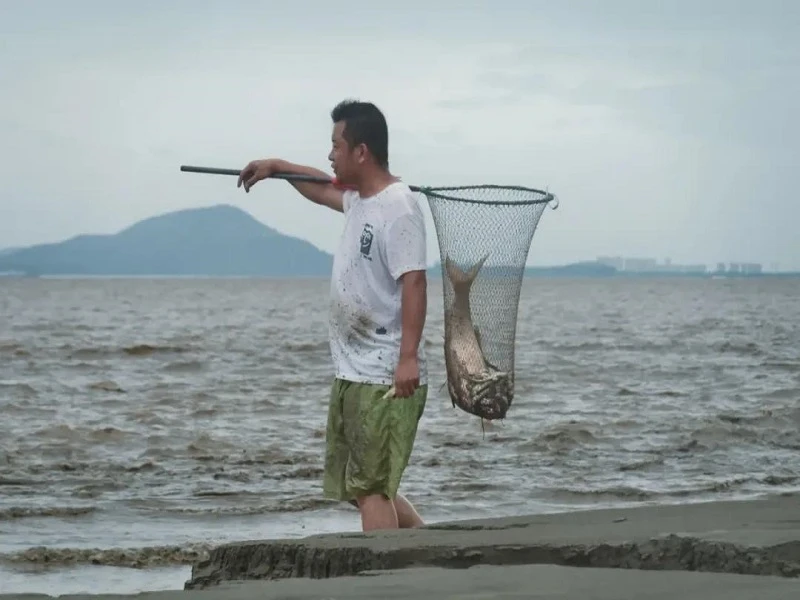For centuries, the people living along the Qiantang River (钱塘江) in China engaged in a unique and perilous way of life: competing to catch "tide fish" at the river’s edge during the tidal surges. This practice, known as "chasing the tide," was both a means of livelihood and a dangerous game where participants faced nature's full wrath. Despite the risks, which resulted in numerous fatalities over the years, this tradition carried on until authorities eventually prohibited it, placing warning signs along the riverbank that read, “Danger: Tidal surge. Do not enter.”
However, a new wave of excitement has emerged around the old tradition, propelled by social media. Videos of people chasing tide fish have gone viral, bringing modern fame to those daring enough to challenge the tides. Tire repair shops close, rideshare drivers turn off their apps, and groups of friends rush to the river to test their skills and luck. What was once a dangerous profession has transformed into a social media spectacle, where the pursuit of fish and fame intertwines.

A New Breed of Tide Chasers
With fishing nets in hand, today’s tide chasers stand at the edge of the river, awaiting the surge. Facing the churning, dark waters head-on, they strive to catch as many fish as possible, all while drones buzz above, capturing the drama for millions of online viewers. Some chasers, like a man known only as “Red Shorts,” have become legends in the community. His bright red shorts, worn in honor of his zodiac year, have made him a recognizable figure on the muddy shores of the Qiantang River. In an effort to distinguish himself from imitators, Red Shorts recently started wearing a blue hat, adding to his iconic status.
Red Shorts is known for his fearlessness and unparalleled speed, often sprinting twice as far as others to reach the most dangerous parts of the tide. While most people avoid the roughest sections of the river, where the muddy waters swirl unpredictably, he seeks them out. The telltale sign of a particularly vicious surge is the appearance of frothy, white waves—a signal that Red Shorts heeds with both caution and excitement.
For the uninitiated, chasing tide fish might appear to be a game of luck. But in reality, it requires a keen eye, physical endurance, and a deep understanding of the river’s currents. Veterans like Red Shorts can assess water patterns in real-time, determining where fish might surface and when it’s safe to charge forward. Yet, even with skill, the river is an unpredictable force. As one local tide chaser said, "If Red Shorts doesn’t catch any fish, it’s likely no one else will either."
Local legend has it that if you’re unlucky, you might end up with the nickname “Air Force One”—a term reserved for those who return empty-handed. But for the true tide chasers, it’s not just about catching fish. It’s about testing one’s limits, about that brief moment when they stand at the threshold between life and death, racing against the surge.
While some of the tide chasers engage in this activity for the adrenaline rush, others see it as an escape from the mundanity of everyday life. The surge becomes a temporary reprieve from routine. For a short while, these chasers can forget about their work or family responsibilities and simply focus on the river and the task at hand. Whether they return home empty-handed or victorious, they share a sense of camaraderie and mutual respect forged in the heat of competition.
The Tide Masters and Their Legends
Amid the tide chasers, certain figures have become folk heroes, their feats told and retold in local taverns and online forums. One such figure is Hong Lang, a 50-year-old tide chaser who has spent a decade perfecting his craft. Nicknamed “The Shaolin Disciple” for his acrobatic abilities, Hong Lang is known for his solitary nature. While most tide chasers work in groups for safety, he prefers to chase the tide alone, avoiding the potential liability of getting others involved in case of an accident.
Hong Lang has saved more than one life during his years on the river. When someone is swept off their feet by the tide, Hong Lang is often there to guide them to safety. But despite his skills, he never lingers to form friendships or alliances. As he sees it, fishing is a solitary pursuit, one that requires focus and precision. He’s not there to make friends—he’s there to catch fish and survive the tide.
Unlike Hong Lang, Red Shorts thrives on the social aspect of tide chasing. He encourages competition, assigning nicknames to his peers, testing their physical abilities, and organizing informal races on the beach. His group, a mix of tide chasers from various regions like Hunan, Henan, and Sichuan, represents a new wave of outsiders who have taken over the sport from the local Zhejiang residents. Together, they race against the tide, fight for fish, and cement their reputations in the online world.
In the sweltering heat of summer or the biting cold of winter, tide chasers continue to gather on the banks of the Qiantang River. The thrill of the chase and the allure of fame keep drawing them back, despite the risks. For some, it’s a tradition passed down through generations; for others, it’s a newfound passion, fueled by the power of social media.
As the tide rolls in, the chasers spread out across the mudflats, ready to meet the river head-on. With each surge, they race against the water, hoping to return with a catch. Whether they succeed or fail, the tide chasers of the Qiantang River are united by their love of the chase—a pursuit that balances on the edge of life and death.



